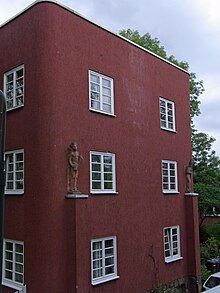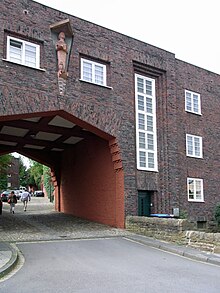Cuno settlement
The listed Cuno settlement is located in Hagen - Wehringhausen on the Kuhlerkamp. It was named after the mayor of Hagen, Willi Cuno .
From 1926 to 1927 121 apartments in 9 buildings were built on the Kuhlerkamp. The apartments had two to five rooms and a Frankfurt kitchen, which was very innovative at the time and separated from the living and dining area by a glass door . In the settlement there were communal facilities such as a laundry and a bathing establishment with shower and bath tubs.
The urban planning officer Ewald Figge, together with the architects Wiehl, Balser, Woltmann, Günther and Büchsenschütz, Wachenfeld and artists, planned the settlement in the New Building style . The strictly factual and geometrically structured apartment blocks are made of concrete, mostly with red plaster and clad with bricks on the front sides and at the gate entrances. At the corners of the house and above the gate entrances there are playful figurative sculptures by Karel Niestrath on small plinths integrated into the building. Next to the entrances and driveways there are reliefs by Hans Dorn . The base of the building is clad with quarry stone, as are the low walls around the small front and larger terrace gardens. The windows are built from a uniform grid, rectangular, white and provided with bars. The doors are highlighted with the stairwells as bay windows over the entire height of the house. The flat roof is accentuated with a metal band.
The gate entrances and the hilly terrain give the settlement block a castle-like character, although it is laid out like a fan with open sides. In addition to the "Cunosiedlung" street, numerous footpaths with stairs lead through the settlement.
Web links
- Description of all locations on this themed route as part of the Route of Industrial Culture
- Architectural tours of the city of Hagen ( Memento from February 7, 2015 in the Internet Archive ) (PDF; 4.8 MB)
Coordinates: 51 ° 21 ′ 29.2 " N , 7 ° 26 ′ 55.4" E






